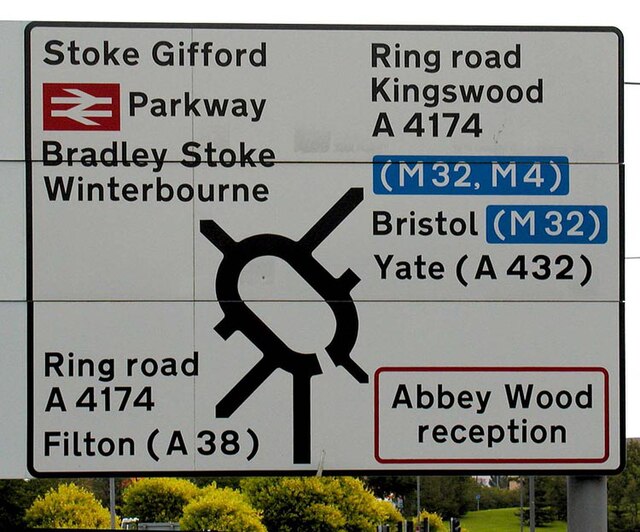Loading AI tools
Road sign typeface used in the United Kingdom From Wikipedia, the free encyclopedia
Transport is a sans serif typeface first designed for road signs in the United Kingdom. It was created between 1957 and 1963 by Jock Kinneir and Margaret Calvert as part of their work as designers for the Department of Transport's Anderson and Worboys committees.[1][2]
 | |
| Category | Sans-serif |
|---|---|
| Classification | Grotesque Mixed Signage |
| Designer(s) | Jock Kinneir Margaret Calvert |
| Date created | 1963 |
 | |
| Sample | |

Before its introduction, British road signs used the capitals-only Llewellyn-Smith alphabet that was introduced following the Maybury Report of 1933 and revised in 1955–57. Older signs, known as fingerposts, tended to use a variety of sans serif alphabets as supplied by their manufacturers. For the kinds of roads on which either of these alphabets was likely to be seen, legibility was not a pressing issue, but the planning and building of Britain's first motorway in the 1950s was a catalyst for change.
The Ministry of Transport appointed an Advisory Committee on Traffic Signs for Motorways under the chairmanship of Sir Colin Anderson in 1957 and Jock Kinneir and his assistant Margaret Calvert were appointed as graphic designers to it. All aspects of signing were investigated and tested, initially on the Preston bypass (1958, now part of the M6 motorway), before their introduction on the (London–Yorkshire) M1 motorway a year later. The committee looked at examples from other European countries as well as the USA but Kinneir and Calvert found them somewhat harsh and unsatisfactory. Instead, they developed a more rounded typeface with distinctive tails to 'a', 't', and 'l', and bar-less fractions, all of which helped legibility.
The department, seeing the successful early results of this work then appointed another committee, under the chairmanship of Sir Walter Worboys and again using Kinneir and Calvert as designers, to look at Traffic Signs for All-Purpose Roads. Work for this also resulted in the introduction of the pictogram signs based on those recommended by the 1949 United Nations World Conference on Road and Motor Transport.
Two forms of the typeface exist; Transport Medium and Transport Heavy. Both have the same basic form, but Transport Heavy is boldface, to allow easier readability of black letters on white backgrounds, such as those used on non-primary roads, while Transport Medium is lighter, and is used for white letters on dark backgrounds, such as the green primary-route signs.[3]
The Transport fonts are the only ones allowed on UK road signs (except for motorway signs, where route numbers appear in their own separate typeface known as Motorway).[4]: Regulation 5 and Schedule 17
Only a limited number of symbols are available in Transport, mainly those commonly used in road signs, such as apostrophes, the pound sign and certain vulgar fractions such as ½ and ⅓. The original Transport fonts contained no diacritics, but since the publication of the 2016 Traffic Signs Regulations and General Directions includes grave accents for use on road signs in Scotland.[4]: Schedule 17
Although developed in the United Kingdom, the typeface has been used in many other countries around the world. In addition to the Crown dependencies, British overseas territories and some limited residual usage in Commonwealth states, the typeface is also used in Hong Kong, Iceland, Ireland, Greece (on non-motorway roads), and Portugal, and in much of the Middle East. Denmark uses a variation with added spacing and modified numerals, known as Dansk Vejtavleskrift. Italy and Spain use bolder variants, called Alfabeto Normale in Italy and Carretera Convencional in Spain. In many countries, the typeface has been adapted to include diacritics and other letters not used in English.
In countries where other scripts (such as the Perso-Arabic script) are used, Transport is often used for Latin transliterations.[1][5] Road signs in the Republic of Ireland use all-caps Transport Heavy for English names; for Irish names, mixed-case Transport Heavy oblique is used with variants for A, a, i, M and N: script a, dotless i, and tall versions of m and n.
In Indonesia, variable message signs/electronic signs have used Transport since April 2014.[6]
The original Transport family, with its two weights, has been digitised by URW++.[7]
It is an updated and expanded version of the original typeface, been developed by Henrik Kubel of A2/SW/HK Limited and Margaret Calvert during 2012.
The original release includes six different weights (Thin, Light, Regular, Medium, Bold, Black) with complementary oblique stylings. It also has other features including text figures and small capitals.[8] Semibold weight was added between 2018-08-29[9] and 2018-09-02.[10]
Logo of the American cybersecurity and data backup company, Datto, Inc. used New Transport Medium typeface.
It is a custom version of New Transport designed by New Transport designers, for use in the UK Government Digital Service web site (GOV.UK) in 2012, where it has been selected as the sole font for all text.[11][12]
An updated though unofficial family based upon Transport was first released by independent foundry K-Type in 2008. The family includes Light, Medium and Heavy weights along with true italics which were added in 2015.[13]
This family is the main UI typeface of Untitled Goose Game made by House House in 2019.
Jörg Hemker designed two typefaces that are inspired from the Transport typeface: FF Nort and FF Nort Headline. Both typefaces support Greek and Cyrillic.[14][15]
Seamless Wikipedia browsing. On steroids.
Every time you click a link to Wikipedia, Wiktionary or Wikiquote in your browser's search results, it will show the modern Wikiwand interface.
Wikiwand extension is a five stars, simple, with minimum permission required to keep your browsing private, safe and transparent.